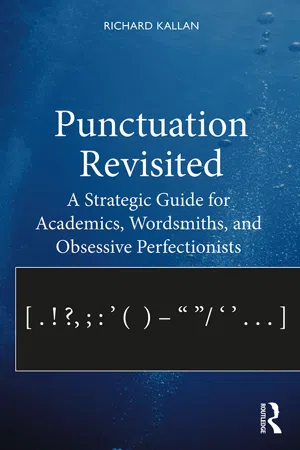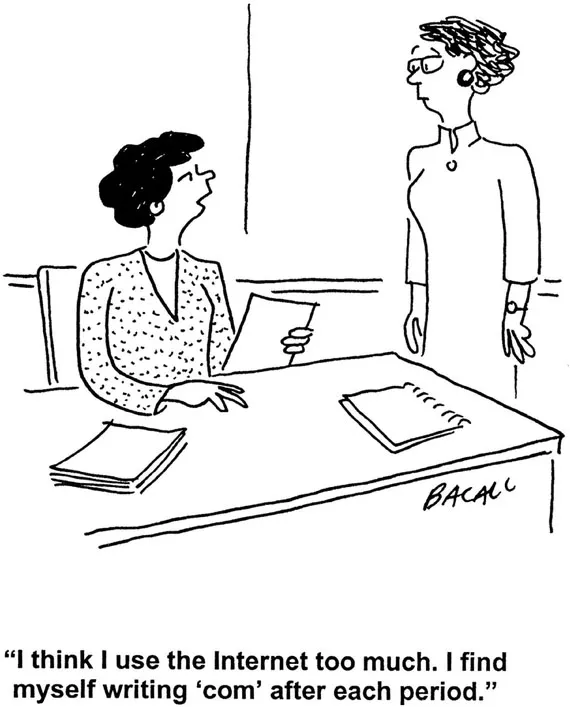
Punctuation Revisited
A Strategic Guide for Academics, Wordsmiths, and Obsessive Perfectionists
- 140 pages
- English
- ePUB (mobile friendly)
- Available on iOS & Android
Punctuation Revisited
A Strategic Guide for Academics, Wordsmiths, and Obsessive Perfectionists
About this book
Punctuation Revisited is an advanced, comprehensive guide to the importance of punctuation in conveying meaning and augmenting the power of a message.
Richard Kallan provides guidance on how to structure sentences accurately and in a manner that enhances their readability and rhetorical appeal. This book discusses in fine detail not just when and how to employ specific punctuation marks, but the rationale behind them. It also notes when the major academic style manuals differ in their punctuation advice. These unique features are designed to benefit beginning, intermediate, and advanced students of standard punctuation practice.
Punctuation Revisited is a wonderful resource for students of composition and writing, an essential read for writing center tutors and faculty, as well as the perfect addition to anyone's professional library.
Frequently asked questions
- Essential is ideal for learners and professionals who enjoy exploring a wide range of subjects. Access the Essential Library with 800,000+ trusted titles and best-sellers across business, personal growth, and the humanities. Includes unlimited reading time and Standard Read Aloud voice.
- Complete: Perfect for advanced learners and researchers needing full, unrestricted access. Unlock 1.4M+ books across hundreds of subjects, including academic and specialized titles. The Complete Plan also includes advanced features like Premium Read Aloud and Research Assistant.
Please note we cannot support devices running on iOS 13 and Android 7 or earlier. Learn more about using the app.
Information
1
PERIODS, QUESTION MARKS, AND EXCLAMATION POINTS
Purpose and Application
- I [subject] enjoy [verb] my writing class.
- I [subject] enjoy my writing class [predicate] .
- Writing is fun.
- Writing = fun.
- Writing [subject] is [linking verb] fun [condition].
- Writing [subject] is fun [predicate] .
- Although I love to write.
- When class starts.
- If I may ask.
Periods

Ending a Sentence
- This is an example of a sentence that ends with a period.
- This is another example. And here's one more.
Providing Visual Closure
- TECHNICAL SKILLS. I am proficient in . . .
- WORK EXPERIENCE. My industry experience includes working at . . .
- EDUCATION BACKGROUND. As my resume details, I earned a BA from. . .
Following Abbreviations1






| F. Scott Fitzgerald | HunterS.Thompson | J.K.Rowling | J.R.R. Tolkien |
| FDR | JFK | LBJ | MLK |
Table of contents
- Cover
- Half Title
- Title
- Copyright
- Dedication
- Contents
- Acknowledgments
- Author's Background
- Introduction
- Functions of Punctuation
- Why This Book?
- Organization of Chapters
- Notes
- 1 Periods, Question Marks, and Exclamation Points
- Purpose and Application
- Quick Reference Glossary
- Periods
- Ending a Sentence
- Providing Visual Closure
- Following Abbreviations
- Following Numbered and Lettered Items
- Positioning with Quotation Marks and Italicized Titles
- Positioning with Parentheses
- Positioning with Footnotes/Endnotes
- Positioning with Parenthetical Information
- Question Marks
- Posing a Direct Question
- Posing an Indirect Question
- Following Abbreviations
- Positioning with Quotation Marks and Italicized Titles
- Positioning with Parentheses
- Positioning with Other Forms of Punctuation
- Exclamation Points
- Following Exclamations
- Following Abbreviations
- Positioning with Quotation Marks and Italicized Titles
- Positioning with Parentheses
- Positioning with Other Forms of Punctuation
- Rhetorically Speaking
- Key Differences between American and British Style
- Notes
- 2 Commas
- Purpose and Application
- Separating Independent Clauses
- Separating Items in a Series
- AP Stylebook, Chicago, APA, MLA, and Oxford Style
- Separating Dependent Clauses
- Separating Adjectival Clauses
- Separating Appositives
- Separating Transitional Words and Phrases
- Separating Introductory Adverbs
- Separating Other Introductory Words
- Separating Adverbial Phrases
- Separating Participial Phrases
- Separating Participial and Adverbial Phrases in a Compound Sentence
- Chicago
- Separating Absolute Phrases
- Separating Coordinate Adjectives
- Separating Parenthetical Material
- Rhetorically Speaking
- Separating Contrasting Material
- Separating Direct Questions
- Separating Tag Questions
- Separating Indirect Quotations
- Signifying Omitted Words
- Avoiding Confusion
- Separating Abbreviations
- Separating Elements in a Date
- Chicago
- Separating Elements in an Address
- Separating Numbers
- Rhetorically Speaking
- Notes
- 3 Semicolons
- Purpose and Application
- Connecting Related Independent Clauses
- Rhetorically Speaking
- Chicago
- Rhetorically Speaking
- Separating Items in a Series
- Rhetorically Speaking
- Eliminating Incorrect Semicolon Use
- Rhetorically Speaking
- Rhetorically Speaking
- Notes
- 4 Colons and Dashes
- Purpose and Application
- Colons
- Introducing a List
- Rhetorically Speaking
- Introducing Supplemental Information
- Introducing Quotations, Salutations, Subtitles, and Dialogue
- Separating Other Data
- Rhetorically Speaking
- Dashes
- Formatting Dashes
- AP Stylebook
- Emphasizing Parenthetical Information
- Rhetorically Speaking
- Completing a Sentence's Meaning
- Introducing a List
- Avoiding Confusion
- Showing Interrupted Speech
- Formatting Special Cases of Source Attribution
- Signifying Missing Words or Letters
- Omitting Preceding and Following Punctuation
- Rhetorically Speaking
- Notes
- 5 Apostrophes
- Purpose and Application
- Indicating Possession
- Chicago
- MLA
- APA
- AP Stylebook
- Chicago
- Rhetorically Speaking
- Chicago
- AP Stylebook
- Chicago
- AP Stylebook
- Rhetorically Speaking
- AP Stylebook
- Signifying Missing Letters and Numbers
- Rhetorically Speaking
- Avoiding Confusion
- MLA
- Rhetorically Speaking
- Key Differences between American and British Style
- Notes
- 6 Double and Single Quotation Marks
- Purpose and Application
- Double Quotation Marks
- Quoting Others
- Rhetorically Speaking
- Introducing Quotations
- Introducing Block Quotations
- Quoting Dialogue
- Positioning Commas and Periods within Quotations
- Paraphrasing Quotations
- Placing Other Works in Quotation Marks
- AP Stylebook
- Calling Attention to Specific Words
- Rhetorically Speaking
- Single Quotation Marks
- Quoting within a Quotation
- AP Stylebook
- Key Differences between American and British Style
- Notes
- 7 Ellipses and Slashes
- Purpose and Application
- Ellipses
- Formatting Ellipses
- AP Stylebook
- Omitting Text
- AP Stylebook
- Chicago
- AP Stylebook
- Chicago
- AP Stylebook
- Using Ellipses as a Literary Device
- Chicago
- Eliminating Unnecessary Ellipses
- Rhetorically Speaking
- Key Differences between American and British Style
- Slashes
- Pairing Words
- Chicago
- Rhetorically Speaking
- Separating Lines of Poetry
- Abbreviating and Formatting Information
- Notes
- 8 Parentheses and Brackets
- Purpose and Application
- Parentheses
- Subordinating Information
- Rhetorically Speaking
- Positioning Commas with Parentheses
- Enclosing Numbers and Letters with Parentheses
- Eliminating Unnecessary Parentheses
- Rhetorically Speaking
- Brackets
- Commenting Editorially
- AP Stylebook
- Bracketing Parenthetical Information within Parentheses
- Editing Quotations
- Rhetorically Speaking
- Key Differences between American and British Style
- Notes
- Index